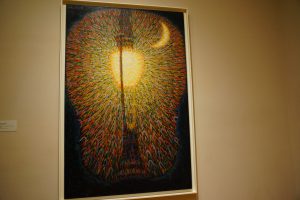Giacomo Balla, born in Turin in 1871, was an Italian artist and founding member of the Futurist movement in painting. In his paintings, he represented light, movement, and speed.

Image source:https://commons.wikimedia.org/wiki/File:Balla_-_Mercurio_passa_davanti_al_sole.jpg
Giacomo Balla was an Italian Futurist artist known for his geometric paintings depicting light and movement. Influenced by contemporaries Umberto Boccioni and Gino Severini, he was inspired by technology and industrialization.
Early life
At the age of nine, after the death of his father, he abandoned music and started working in a lithograph print house. At the age of 20, he decided to study painting in local academies, and many of his early works were shown at exhibitions. After his academic studies at the University of Turin, Balla moved to Rome in 1895, where he met and then married Elisa Marcucci. He worked as an illustrator, caricaturist, and portraitist for several years in Rome. In 1899, his work was exhibited at the Venice Biennale, and subsequently, his art reached the main exhibitions in Rome, Venice, Munich, Berlin, Düsseldorf, at the Salon d’Automne in Paris, and at the Rotterdam galleries.

Image source: https://search.creativecommons.org/photos/2e7e8173-6849-4931-b0b0-dad5d884ea15
Around 1902, he taught Divisionist techniques to Umberto Boccioni and Gino Severini. Following the influence of Filippo Tommaso Marinetti, Balla adopted the Futurist style, creating a pictorial representation of light, movement, and speed also becoming one of the signatories of the Futurist Manifesto in 1910.
The futurist period

Image source:https://search.creativecommons.org/photos/cbe179f1-40c7-4272-96a5-77baa295c417
Balla was among those who signed the Manifesto of the Futurist artists and the technical Manifesto of futurist art in 1910. Despite his adhesion to modern themes, until 1912 he continued with his pointillist style as in his painting “The Arc Lamp” (Lampada ad arco) of 1909, a work included in the catalog of the futurist exhibition of 1912 at the Galerie Bernheim-Jeune in Paris, although it was not exhibited there. Right from the start, his interest in science, the chronophotography of Etienne Jules Marey, and the photodynamic works of Anton Giulio Bragaglia induced Balla to follow a very different style and the idea of futurism to that of Boccioni.
The theatre and futurism

Image source:https://en.wikipedia.org/wiki/Giacomo_Balla
In 1914 he took part as actor and art director in the theatrical performances of Francesco Cangiullo and composed “Words at liberty” (Parole in libertà). In 1915, together with Depero, he published the futurist reconstruction of the universe manifesto that augured an aesthetic futurist application to fashion, decor, and all other aspects of modern life. Together they produced a series of non-figurative constructions, or plastic art, in cardboard, sheet metal, silk, and other everyday materials. Between 1914 and 1915 Balla composed the interview display cycle, in which he declaimed the futurist artists’ patriotic enthusiasm for Italy’s entry into the war. During the war years, his study became the meeting place for young artists. In 1917 he designed the scenes for Sergei Diaghilev‘s Fireworks ballet, with music by Igor Stravinski.
Decorative art
With increasing passion, Balla dedicated himself to decorative art, and in 1920 opened his Nicolò Porpora house to exhibit the first vividly colored setting. Between 1921 and 1922 he designed the Tic-Tac Bal–a dance hall in futurist style, and in 1925 with Depero and Prampolini he took part at the Exposition des arts dècoratifs (decorative art exhibition) in Paris. He was so struck by Rodchenko and El Lissitsk’s Russian pavilion and “L’Esprit Nouveau” pavilion of Le Corbusier that this inspired him to create constructivist-inspired works such as “Enamoured numbers” (Numeri innamorati) in 1923, which is also close to the mechanical images of Ivo Pannaggi and Vinicio Paladini.

Image source: https://search.creativecommons.org/photos/1e6bcdf8-4e5a-46bf-9fd9-8c92b099324e
Realism
At the end of the ‘thirties, Balla broke away from futurism, convinced that pure art has to express absolute realism, without which it would fall into an ornamental and decorative form. Despite a brief period of success in the ‘fifties, during which his futurist works were esteemed by the younger generation of abstract painters, the “Origin” group, who arranged an exhibition of his works in 1951, Balla’s style remained figurative until his death.
Info sources: https://www.britannica.com/biography/Giacomo-Balla https://en.wikipedia.org/wiki/Giacomo_Balla http://www.artnet.com/artists/giacomo-balla/ https://www.artinvest2000.com/balla_english.htm
